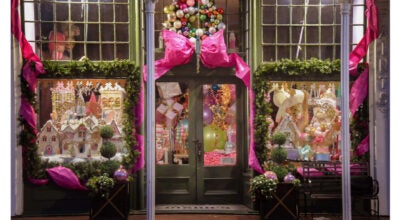History in its veins
Published 12:06 am Sunday, August 23, 2015

SAM GAUSE/THE NATCHEZ DEMOCRAT — Master artisan Chris Landers has finished the National Park Service’s recreation of the original paint finish on Melrose. The house had been covered with white paint for more than 100 years. This project, along with others on the property, is meant to bring the house as close to its original condition as possible.
NATCHEZ — For the past six years, the National Park Service has been chipping away at layers of antebellum Melrose’s history.
Buried underneath more than 100 years of white paint are remnants of the original faux-marble paint finish that now can be seen by Melrose visitors.
When the NPS set out to remove the white paint, reveal the original stucco and recreate the finish on the exterior of Melrose, it soon discovered the project would become more extensive, Natchez National Historical Park Superintendent Kathleen Bond said.
Architectural conservator George Fore discovered water damage at Melrose, which Bond said meant the park service had to completely redo the slate roof, copper gutters and the widow’s walk on top of the house, as well as replace bad wood in the attic and galleries and address the crumbling capitals and leaning chimney.
After that work was complete, the next task was determining what the faux-marble finish looked like on the exterior of the house.
Historic black and white photographs from 1889 and sections of the original faux-marble paint finish still visible on the outside of Melrose were used to determine the original paint colors.
“I would say that was the most challenging part,” local master artisan Chris Landers said.
It took Landers six months to paint the recreation of the faux finishes on the interior and exterior of Melrose, a project he wanted to be a part of upon first learning about it five years ago.
“Ever since I heard there was a hand-painted faux-marble finish at Melrose, I knew I wanted it was something I wanted to do,” he said.
Three different shades of beige acrylic paint were used to recreate the faux-marble effect.
The most challenging part was getting the colors right,” Landers said.
In addition to the outside painting, Melrose also has wood elements that were faux painted. Cypress was used for its durability, Bond said, and the faux finishes were added to create a look of opulence.
“Just as they had the finest furniture money could buy, they have the finest exterior money could buy,” Bond said.
The faux-marble finish illustrates the Greek Revival architecture for which Melrose is known. Many people often associate white columns with antebellum houses and do not realize faux-marble paint finishes were common in Natchez, park service historian Jeff Mansell said.
“These houses were built to look like Grecian temples, but when this faux finish wasn’t fashionable anymore, it was painted over,” Mansell said. “But this technique was more common than people think it was.”
Melrose’s faux-marble paint finish was painted over around 1905, Mansell said.
While paint finishes and colors may seem like a small element of Melrose’s history, Bond said they help tell a much larger story and are valuable aspects of historic interpretation of the house.
“It’s partly preservation of the house; we have to keep a paint job on it,” Bond said. “But it’s also a piece on interpretation.
“It’s part of people trying to experience what it was like when the wealthy planter class were the 1-percenters, and we had this institutional system of chattel slavery,” Bond said.
Melrose has layers of significance Bond said, and the paint is just another layer of the story.
“Melrose is nationally significant on a number of layers, and one of those is architecture,” she said. “It is considered by some scholars as the finest example of domestic Greek revival architecture in the country. This project is a way of better articulating that architectural gem that is here in Natchez.”
Visitors will be able to experience Melrose for free Aug. 25 as the NPS celebrates its 99th birthday by waiving admission to Melrose.
“A national park is not just an idea; it’s a place you go to experience history,” Bond said. “Visitors can get that experience when they walk up to Melrose and they can’t get it anywhere else.”





